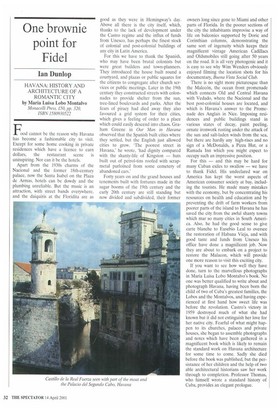One brownie point for Fidel
Ian Dunlop
HAVANA: HISTORY AND ARCHITECTURE OF A ROMANTIC CITY by Maria Luisa Lobo Montaivo
Monacelli Press, £50, pp. 320, ISBN 1580930522
Food cannot be the reason why Havana has become a fashionable city to visit. Except for some home cooking in private residences which have a licence to earn dollars, the restaurant scene is uninspiring. Nor can it be the hotels.
Apart from the 1930s charms of the Nacional and the former 18th-century palace, now the Santa Isabel on the Plaza de Arrnas, hotels can be dowdy and the plumbing unreliable. But the music is an attraction, with street bands everywhere, and the daiquiris at the Floridita are as
good as they were in Hemingway's day. Above all there is the city itself, which, thanks to the lack of development under the Castro regime and the influx of funds from Unesco, has perhaps the finest stock of colonial and post-colonial buildings of any city in Latin America.
For this we have to thank the Spanish, who may have been brutal colonists but were great builders and town-planners. They introduced the house built round a courtyard, and plazas or public squares for the citizens to congregate after church services or public meetings. Later in the 19th century they constructed streets with colonnades to provide shelter from the sun, tree-lined boulevards and parks. After the fears of piracy had died away they also favoured a grid system for their cities, which gives a feeling of order to a place which could easily descend into chaos. Graham Greene in Our Man in Havana observed that the Spanish built cities where they settled, but the English just allowed cities to grow. The poorest street in Havana,' he wrote, 'had dignity compared with the shanty-life of Kingston — huts built out of petrol-tins roofed with scrapmetal purloined from some cemetery of abandoned cars.'
Forty years on and the grand houses and tenements built with fortunes made in the sugar booms of the 19th century and the early 20th century are still standing but now divided and subdivided, their former
owners long since gone to Miami and other parts of Florida. In the poorer sections of
the city the inhabitants improvise a way of life on balconies supported by Doric and Corinthian columns, demonstrating the same sort of ingenuity which keeps their magnificent vintage American Cadillacs and Oldsmobiles still going after 50 years on the road. It is all very photogenic and it is easy to see why Wirn Wenders obviously enjoyed filming the location shots for his documentary, Buena Vista Social Club.
There is no sight more picturesque than the Malecon, the ocean front promenade which connects Old and Central Havana with Vedado, where the Nacional and the best post-colonial houses are located, and which is Havana's answer to the Prome nade des Artglais in Nice. Imposing residences and public buildings stand in various states of decay, paint peeling, ornate ironwork rusting under the attack of the sun and salt-laden winds from the sea, but there are hardly any high-rises and no sign of a McDonalds, a Pizza Hut, or a Ramada Inn which you might expect to occupy such an impressive position.
For this — and this may be hard for many Cuban exiles to swallow — we have to thank Fidel. His undeclared war on America has kept the worst aspects of American consumer society at bay, includ ing the tourists. He made many mistakes with the economy, but by concentrating his resources on health and education and by preventing the drift of farm workers from poorer parts of the island to Havana he has saved the city from the awful shanty towns which mar so many cities in South Ameri ca. Also, he had the good sense to give carte blanche to Eusebio Leal to oversee the restoration of Habana Vieja, and with good taste and funds from Unesco his office have done a magnificent job. Now they are about to embark on a project to restore the Malacon, which will provide one more reason to visit this exciting city.
If you want to see how well they have done, turn to the marvellous photographs in Maria Luisa Lobo Montalvo's book. No one was better qualified to write about and photograph Havana, having been born the child of two of Cuba's greatest families, the Lobos and the Montalvos, and having experienced at first hand how sweet life was before the revolution. Castro's victory in 1959 destroyed much of what she had known but it did not extinguish her love for her native city. Fearful of what might happen to its churches, palaces and private houses, she began to assemble photographs and notes which have been gathered in a magnificent book which is likely to remain the standard work on Havana architecture for some time to come. Sadly she died before the book was published, but the persistance of her children and the help of two able architectural historians saw her work through to completion. Professor Thomas, who himself wrote a standard history of Cuba, provides an elegant prologue.


























































 Previous page
Previous page